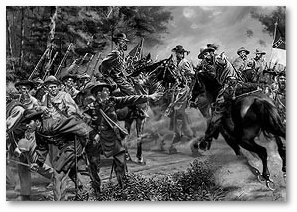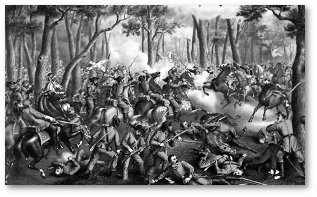|
|
|
MAIN MENU |
| Home |
| Civil War Battles |
|
TIMELINE |
| 1860 |
| 1861 |
| 1862 |
| 1863 |
| 1864 |
| 1865 |
|
VETERANS |
| Honor A Veteran |
| View Veterans |
| Women In The War |
|
MUSIC |
| Union |
| Confederate |
|
UNIFORMS |
| Union |
| Confederate |
|
WEAPONS |
| Union |
| Confederate |
|
CONTACT US |
| Guestbook |
CIVIL WAR BATTLES - Battle of the Wilderness
|
May 5 - 7, 1864
|
 The Battle of the Wilderness was the first battle of Lieutenant Gen. Ulysses S. Grant's 1864 Virginia Overland Campaign against Robert E. Lee and the Confederate Army of Northern Virginia.
The Battle of the Wilderness was the first battle of Lieutenant Gen. Ulysses S. Grant's 1864 Virginia Overland Campaign against Robert E. Lee and the Confederate Army of Northern Virginia.
Going into this battle, the Union had 101,895 soldiers. Their casualties were: 5,597 killed, 21,463 wounded, and 10,667 captured or missing. The Confederate Army of Northern Virginia was 61,025 men strong with casualties of 2,000 killed, 6,000 wounded and 3,400 captured or missing. While waiting for the arrival of Lieut. Gen. Longstreet's 1st Corps, which had been posted 25 miles to the west to guard the railroad junction at Gordonsville, Lee pushed forward his 2nd Corps, commanded by Lieut. Gen. Ewell, and the 3rd Corps under the command of Lieut. Gen. A.P. Hill, in an effort to engage Grant before he moved south. The Confederates were able to do this, and on May 5th both Ewell and Hill clashed with Union soldiers. On the left, Ewell met up with the 5th Corps under the command of Maj. Gen. Warren, and fought to a standoff. For much of the day, Ewell's 20,000 man corps actually held a slight advantage numerically, on this part of the field. But on the right, Hill was hard hit and driven back by the Union 2nd Corps under the command of Maj. Gen. Whinfield Scott Hancock and a division from the 6th Corps.
 On May 6th, Hancock, now commanding close to 40,000 men, resumed the attack on Hill's corps, while heavy Union replacements on Ewell's front prevented Lee from sending 2nd Corps men to aid Hill. By late morning, Hancock had driven Hill's corps back more than 2 miles and had inflicted heavy casualties. With the 3rd Corps in dire straits, Lee began to look desperately for Longstreet, whose arrival had been expected hours before.
On May 6th, Hancock, now commanding close to 40,000 men, resumed the attack on Hill's corps, while heavy Union replacements on Ewell's front prevented Lee from sending 2nd Corps men to aid Hill. By late morning, Hancock had driven Hill's corps back more than 2 miles and had inflicted heavy casualties. With the 3rd Corps in dire straits, Lee began to look desperately for Longstreet, whose arrival had been expected hours before.
Around noon, Longstreet and his 20,000 man 1st Corps arrived, its timing was perfect. Hancock's men were tired and disorganized after 6 hours of fighting. When Longstreet hurled his forces against the Union, they recoiled and within 2 hours the situation was totally reversed. Not only had Longstreet recovered all the lost ground, but he'd advanced another mile past that, forcing Hancock to regroup along Brock Road. The fighting eventually wound down. Longstreet had been badly wounded, and didn't return to the Army of Northern Virginia for several months. Ironically, Longstreet, and fellow General Stonewall Jackson, had both been victims of friendly fire. On May 8th, Grant ordered the Army of the Potomac to resume its advance, and a few days later the armies clashed again at the Battle of Spotsylvania Court House. |
